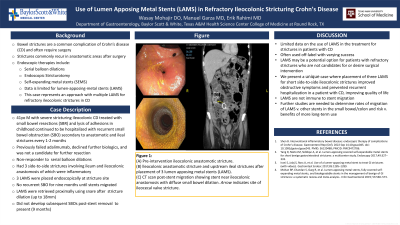Tuesday Poster Session
Category: IBD
P4428 - Use of Lumen Apposing Metal Stents (LAMS) in Refractory Ileocolonic Stricturing Crohn’s Disease
Tuesday, October 29, 2024
10:30 AM - 4:00 PM ET
Location: Exhibit Hall E

Has Audio
- WM
Wasay A. Mohajir, DO
Baylor Scott & White Medical Center
Round Rock, TX
Presenting Author(s)
Wasay A. Mohajir, DO, Manuel Garza, MD, Erik Rahimi, MD
Baylor Scott & White Medical Center, Round Rock, TX
Introduction: Bowel strictures are a common complication of Crohn’s disease (CD) and despite medical therapy often require surgery. Strictures can recur in anastomotic areas after surgery. Endoscopic therapies include serial balloon dilations, stricturotomy, and placement of self-expanding metal stents (SEMS). Data is limited for lumen-apposing-metal stents (LAMS). This case represents a non-surgical approach with multiple LAMS for ileocolonic strictures in CD.
Case Description/Methods: A 41 year old male with severe ileocolonic CD complicated by recurrent small bowel obstructions (SBO) with multiple childhood abdominal surgeries, including small bowel resections and lysis of adhesions complicated by ileocolonic anastomotic and ileal strictures presented to hospital with monthly admissions for SBO. He failed adalimumab previously and was not on a biologic. Surgeons deemed he was high risk of short bowel syndrome with further resections. Initially, he had colonoscopy with balloon dilation to 15 mm. Two months later, he was again admitted for SBO from his refractory strictures. Two LAMS were placed via colonoscopy. Two weeks later he had readmission for SBO. Repeat colonoscopy showed patent stents, but a new ileal stricture was seen upstream to both stents. A third LAMS was placed. Biopsies of the strictures showed mild active ileitis. After stent placement, he had no recurrent symptoms for nine months. Afterwards, he was readmitted for abdominal pain and CT showed ileitis with two of three stents remaining. Migration of these stents was noted proximally. Repeat colonoscopy showed dislodgement of the two LAMS, erosions, and recurrent strictures. Balloon dilation was performed to 18 mm and both stents were retrieved. He was started on budesonide with improvement of his symptoms. Systemic steroids were avoided due to side effects. Ustekinumab induction was offered but the patient declined due to apprehensiveness towards biologics. He did not want further surgery unless emergent. Five months from stent removal and dilation, he was well and had no further recurrence of SBO.
Discussion: Currently, there is limited data on the use of LAMS in the treatment for strictures in patients with CD. They are often used off-label. This is a novel case where endoscopic balloon dilation with three LAMS for multiple ileocolonic strictures improved obstructive symptoms and prevented recurrent hospitalization in a patient with CD. This case also demonstrates that placement of ileocolonic LAMS may result in stent migration.

Disclosures:
Wasay A. Mohajir, DO, Manuel Garza, MD, Erik Rahimi, MD. P4428 - Use of Lumen Apposing Metal Stents (LAMS) in Refractory Ileocolonic Stricturing Crohn’s Disease, ACG 2024 Annual Scientific Meeting Abstracts. Philadelphia, PA: American College of Gastroenterology.
Baylor Scott & White Medical Center, Round Rock, TX
Introduction: Bowel strictures are a common complication of Crohn’s disease (CD) and despite medical therapy often require surgery. Strictures can recur in anastomotic areas after surgery. Endoscopic therapies include serial balloon dilations, stricturotomy, and placement of self-expanding metal stents (SEMS). Data is limited for lumen-apposing-metal stents (LAMS). This case represents a non-surgical approach with multiple LAMS for ileocolonic strictures in CD.
Case Description/Methods: A 41 year old male with severe ileocolonic CD complicated by recurrent small bowel obstructions (SBO) with multiple childhood abdominal surgeries, including small bowel resections and lysis of adhesions complicated by ileocolonic anastomotic and ileal strictures presented to hospital with monthly admissions for SBO. He failed adalimumab previously and was not on a biologic. Surgeons deemed he was high risk of short bowel syndrome with further resections. Initially, he had colonoscopy with balloon dilation to 15 mm. Two months later, he was again admitted for SBO from his refractory strictures. Two LAMS were placed via colonoscopy. Two weeks later he had readmission for SBO. Repeat colonoscopy showed patent stents, but a new ileal stricture was seen upstream to both stents. A third LAMS was placed. Biopsies of the strictures showed mild active ileitis. After stent placement, he had no recurrent symptoms for nine months. Afterwards, he was readmitted for abdominal pain and CT showed ileitis with two of three stents remaining. Migration of these stents was noted proximally. Repeat colonoscopy showed dislodgement of the two LAMS, erosions, and recurrent strictures. Balloon dilation was performed to 18 mm and both stents were retrieved. He was started on budesonide with improvement of his symptoms. Systemic steroids were avoided due to side effects. Ustekinumab induction was offered but the patient declined due to apprehensiveness towards biologics. He did not want further surgery unless emergent. Five months from stent removal and dilation, he was well and had no further recurrence of SBO.
Discussion: Currently, there is limited data on the use of LAMS in the treatment for strictures in patients with CD. They are often used off-label. This is a novel case where endoscopic balloon dilation with three LAMS for multiple ileocolonic strictures improved obstructive symptoms and prevented recurrent hospitalization in a patient with CD. This case also demonstrates that placement of ileocolonic LAMS may result in stent migration.

Figure: Figure 1: (A) pre-intervention ileocolonic anastomotic stricture. (B) lleocolonic anastomotic stricture and upstream ileal strictures after placement of 3 lumen apposing metal stents (LAMS). (C) Post-stent migration CT scan showing stent near ileocolonic anastomosis with diffuse small bowel dilation. Arrow indicates wall-thickening of terminal ileum at level of ileocecal valve consistent with ileitis.
Disclosures:
Wasay Mohajir indicated no relevant financial relationships.
Manuel Garza indicated no relevant financial relationships.
Erik Rahimi indicated no relevant financial relationships.
Wasay A. Mohajir, DO, Manuel Garza, MD, Erik Rahimi, MD. P4428 - Use of Lumen Apposing Metal Stents (LAMS) in Refractory Ileocolonic Stricturing Crohn’s Disease, ACG 2024 Annual Scientific Meeting Abstracts. Philadelphia, PA: American College of Gastroenterology.
